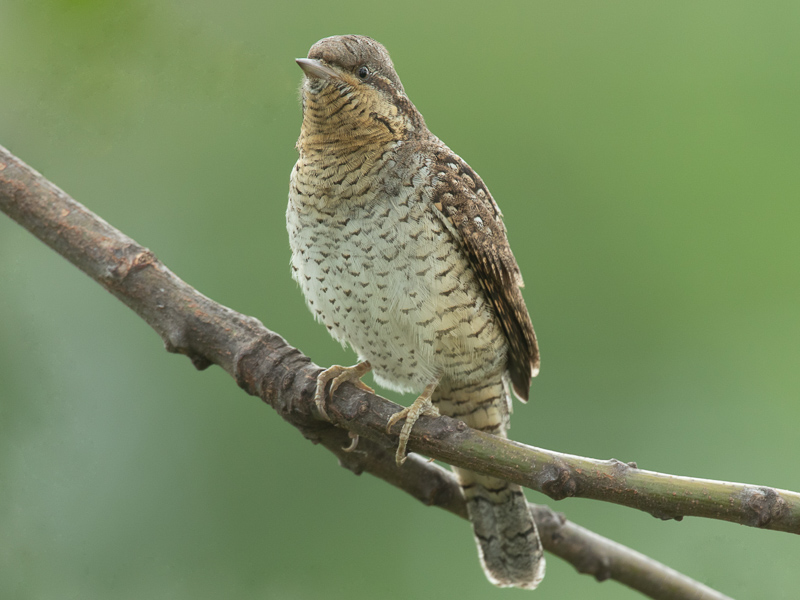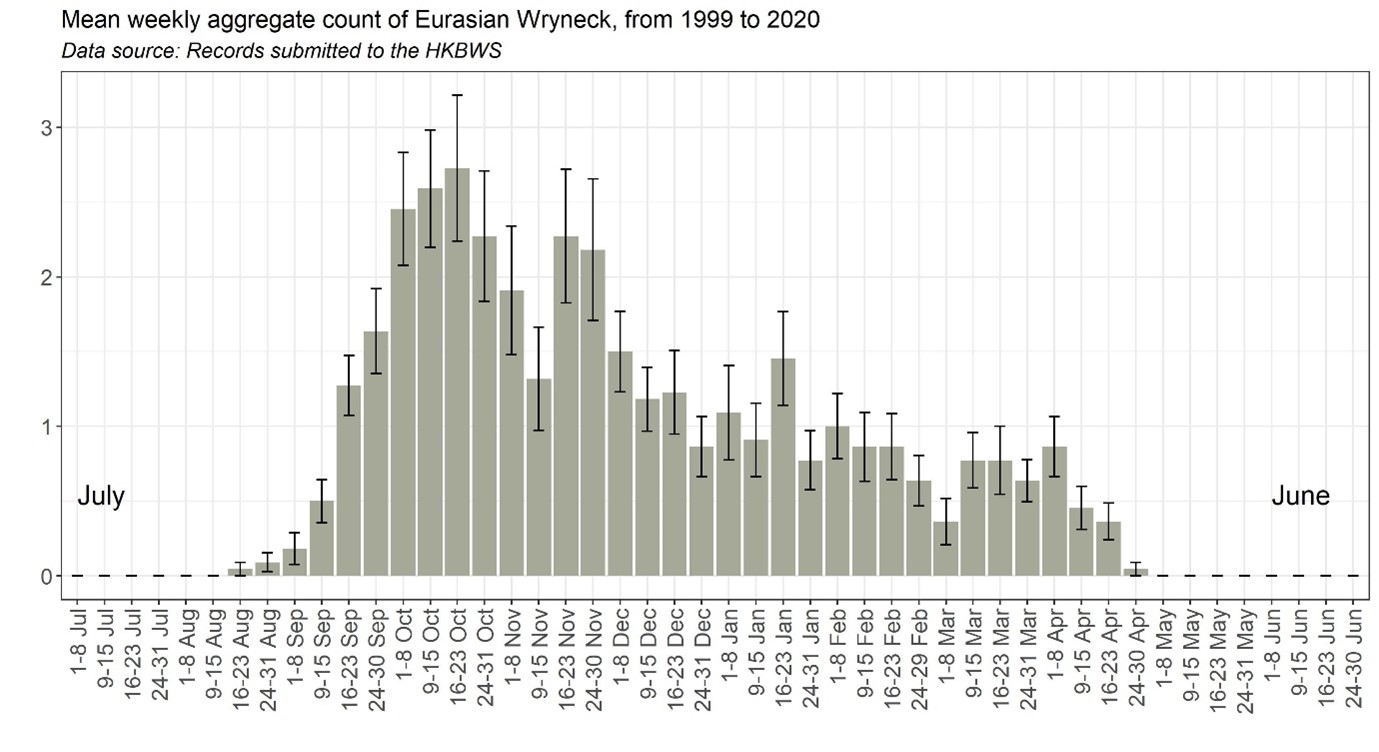Eurasian Wryneck Jynx torquilla 蟻鴷
Category I. Common passage migrant in autumn, uncommon winter visitor and passage migrant in spring; occurs in a variety of semi-wooded and open country habitats.
IDENTIFICATION

Dec. 2014, Michelle and Peter Wong.
16-18 cm. Unusual woodpecker with relatively long tail and short pointed bill. Highly distinctive intricate plumage of brown and grey with darker bars and sparse white spots on wing coverts and scapulars. Crown, nape and hindneck greyish, darker mask from forehead through eye.

Oct. 2018, KWOK Tsz Ki.
The throat and upper chest are buffish, while the rest of the underparts are whitish becoming buffish lower down; narrow, sparse dark bars cover the whole underparts. Wrynecks have zygodactyl feet: two toes point forward and two backward.
VOCALISATIONS
In autumn especially its distinctive song can be heard: ‘kyee kyee kyee’ resembling the call of a small falcon.
DISTRIBUTION & HABITAT PREFERENCE
Eurasian Wryneck is found on active and abandoned agricultural land, marshes and fish pond areas, gardens, city parks and more generally in open areas with low or sparse vegetation where cover is available. Most reports are from the Deep Bay area, but it is also regularly recorded in lowland areas of the New Territories, Lantau, Lamma, and occasionally on offshore islands such as Tung Ping Chau and Po Toi.
OCCURRENCE
Most reports are from the second week of September to the third week of April (Figure 1). The main period of autumn passage occurs in October and November. The decrease in numbers in the first half of November followed by an increase in the second half of the month may indicate a transition between passage migrants and the arrival of winter visitors. Numbers recorded decline through winter and spring, with weak passage occurring from the second week of March. Extreme dates are 17 August 2015 and 24 April 2020.
Most reports refer to one or two birds, but up to three are frequently seen together at Mai Po NR during autumn passage. The longest-staying individual was one at Tai Mei Tuk from 21 October 1981 to 17 March 1982. Year to year site fidelity was shown by one trapped at Mai Po on 8 October 1992 and recaptured there on 14 March 1993 and 26 November 1994.
A decline in numbers since the 1950s may be suggested by the fact that up to five birds were reported on 34 dates, all in the Deep Bay area and central New Territories from 28 September to 23 April, by a single observer (Walker 1958) during two consecutive winters. Since the 1990s the highest single-site count is three. Walker’s series of records was unprecedented, however, as at the time there were only eight previous reports, all in October, March and April (Herklots 1953, Dove and Goodhart 1955), including one at Kam Tin on 21 April 1934 (Pereira and Herklots 1934), the first for HK.
BEHAVIOUR, FORAGING & DIET
Ants are the only food items noted. Habitually perches prominently on leafless trees, wires or fencing, from where it may deliver song even on migration.
RANGE & SYSTEMATICS
Breeds from southwest, central and northern Europe east through Russia, northern Kazakhstan, north Mongolia and northeast China to Sakhalin and Hokkaido, Japan, and southwest to central China; winters in sub-Saharan Africa north of the equator and the Indian subcontinent east to south China and south Japan, and south to peninsula Malaysia (Winkler et al. 2020). In China breeds in the northwest, north and northeast and winters in south Tibet and the area south of the Chang Jiang (Yangtze River) (Liu and Chen 2020).
J. t. chinensis breeds in east Siberia and northeast and central China and is presumed to occur in HK. J. t. himalayana occurs in north Pakistan and the northwest Himalayas, while J. t. sarudnyi breeds in west Siberia. The remaining subspecies breed to the west.
CONSERVATION STATUS
IUCN: Least Concern. Population trend decreasing.
Figure 1.

Dove, R. S. and H. J. Goodhart (1955). Field observations from the Colony of Hong Kong. Ibis 97: 311-340.
Herklots, G. A. C. (1953). Hong Kong Birds. South China Morning Post, Hong Kong.
Liu, Y. and Y. H. Chen (eds) (2020). The CNG Field Guide to the Birds of China (in Chinese). Hunan Science and Technology Publication House, Changsha.
Pereira, R. A. and G. A. C. Herklots (1934). Notes and comments. Ornithology. Hong Kong Naturalist 5: 156-160.
Walker, F. J. (1958). Field observations on birds in the Colony of Hong Kong. Hong Kong Bird Watching Society, Hong Kong (duplicated).
Winkler, H., D. A. Christie, and G. M. Kirwan (2020). Eurasian Wryneck (Jynx torquilla), version 1.0. In Birds of the World (J. del Hoyo, A. Elliott, J. Sargatal, D. A. Christie, and E. de Juana, Editors). Cornell Lab of Ornithology, Ithaca, NY, USA. https://doi.org/10.2173/bow.eurwry.01

